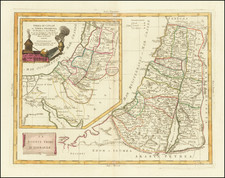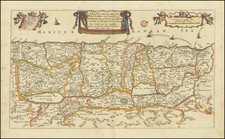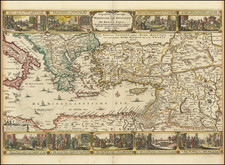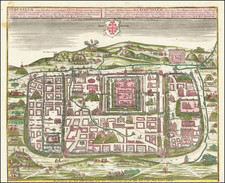An English Holy Land Rarity
First state of this exceeding rare view of Jerusalem and the Promised Land, extending from the Red Sea, Mecca and the Nile River on the right side of the map to Damascus and Sidon on the left side, centered on Jerusalem.
The map shows the Holy Land, the Sinai and the Nile Delta, projected from the East as is often the case but with the Egyptian coast "stretched" to eliminate its western turn. The image is adorned with depictions of villages, towns and fortresses in "bird's-eye perspective" and hundreds of tiny vignettes depicting scenes from the Old and New Testaments. Of further interest are an inset view of the Temple of Solomon, a large inset plan of Jerusalem (its format hearkening back to Visscher's 17th-century plan) and an even larger bird's-eye view of the city, as well as 14 larger vignettes depicting central moments of the Old Testament narrative.
The original prototype for this map seems to have been van Doetechum's 1641 Niewe Caertees das Lants von Beloften ende (Nebenzahl, Holy Land, pp. 120-124). English versions of the view were issued by Overton (ca. 1717), Sayer (ca. 1752), Cluer Dicey (ca. 1765), G. Thompson (1795) and others throughout the 18th century. An American edition was published by Thomas Duffield's map in Philadelphia in 1828.
On the verso, the present map has the following inscription, quite possibly in the hand of Henry Overton:
Map of the Land of Promise & other courious Maps to be put on Linnen Role and few Plates large Size in a Portfolio.
Rarity
The present example is apparently a unique survival.
This is likely the map advertised for sale by Henry Overton in his 1717 catalog, which was described as follows (no known surviving examples).
An Exact Map of Canaan, or the Land of Promise, in Three Sheets, with an Historical Account of that Country, about Four Foot One Inch long, and Two Foot Five Inches deep.
The Overton family was a prominent part of the printing, and mapmaking, industry in London in the seventeenth and eighteenth centuries. John Overton (1639/40-1713) was the son of a tailor who apprenticed to Stationer Thomas Gould. He was made free of the Stationers’ Company in 1663. Two years later, London was struck by the Great Plague of 1665-6. Peter Stent, a leading printseller, succumbed and Overton took over his shop. This burned in the Great Fire of 1666, but Overton had rebuilt by 1669, when he advertised his wares from the White Horse on Snow Hill. Overton specialized in prints, portraits, and especially maps and topographical views.
John was likely married three times and had seven children. His eldest, Thomas, emigrated to America. His second oldest, Henry, was executor of John’s will when the latter died in 1713. Henry (1675/6-1751) acquired his father’s stock in 1707 and ran the shop until his own death in 1751. He published many maps, most focusing on the British Isles. His shop and stock passed to his nephew, another Henry, son of John’s fourth son, James.
Henry the Elder’s brother, Philip (ca. 1681-1745), was also a printer and mapmaker. Philip served as his father’s apprentice and was made free of the Stationers’ in 1702. His father set him up in the trade in 1707 and by 1710 he was working from the sign of the Golden Buck in Fleet Street. Philip specialized in fine arts prints, including Hogarth’s Hudibras set (1726), but he also sold many maps. At his death in 1745 he left his shop to his widow, Mary. She ran the shop and then married James Sayer, whose brother, Robert, became Mary’s assistant. He took over the business in 1748 and became a famous purveyor of maps, charts, and views.
Back at the sign of the White Horse, Henry the Younger continued the family business, expanding their stock to include a large collection of landscape views. He often partnered with Robert Sayer. He continued in business until at least 1764, when he drops out of the historical record.











![[ Holy Altars and Aaron's Tunic ]](https://storage.googleapis.com/raremaps/img/small/98384.jpg)



![[ Promised Lands to the Bordes of Elam or Persia ] Vorstellung der Gegenden zwischen dem gelobten Land und den Grenzen von Elam oder Persien, wie sie in den alten Zeiten bekannt gewesen.](https://storage.googleapis.com/raremaps/img/small/94693.jpg)
